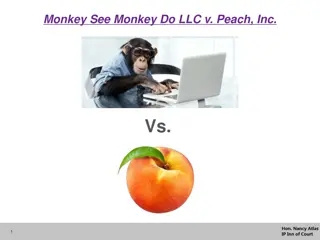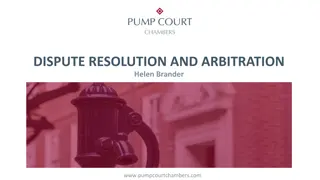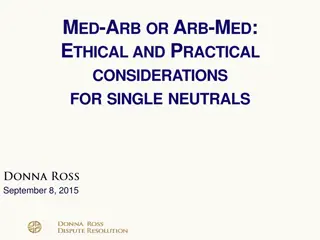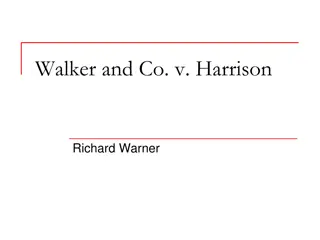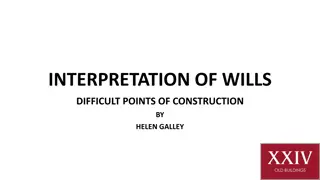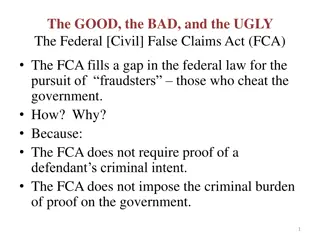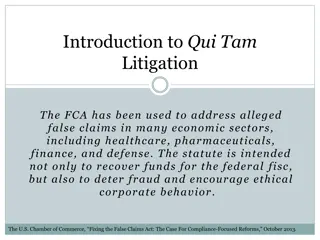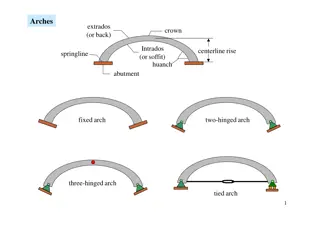Legal Dispute Analysis: FCA v ARCH and Others [2021] UKSC 1
This analysis delves into the legal case of FCA v ARCH and Others [2021] UKSC 1, focusing on key clauses at issue such as disease clauses and prevention of access clauses. It explores the procedural history of the case, including judgments from the Commercial Court and the Supreme Court. The Supreme Court judgment clarifies interpretations of insurance policy language regarding coverage for notifiable diseases within specific radii.
Download Presentation

Please find below an Image/Link to download the presentation.
The content on the website is provided AS IS for your information and personal use only. It may not be sold, licensed, or shared on other websites without obtaining consent from the author.If you encounter any issues during the download, it is possible that the publisher has removed the file from their server.
You are allowed to download the files provided on this website for personal or commercial use, subject to the condition that they are used lawfully. All files are the property of their respective owners.
The content on the website is provided AS IS for your information and personal use only. It may not be sold, licensed, or shared on other websites without obtaining consent from the author.
E N D
Presentation Transcript
FCA v ARCH and OTHERS [2021] UKSC 1 Friday 22 January 2021 @ 10am online Simon Salzedo QC Michael Bolding Sarah Bousfield If you have suggestions for questions for the speakers please submit them via email to marketing@brickcourt.co.uk or use the question box on the control panel brickcourt.co.uk +44(0)20 7379 3550
MICHAEL BOLDING brickcourt.co.uk +44(0)20 7379 3550
TYPES OF CLAUSES AT ISSUE Diseaseclauses Prevention of access clauses Hybridclauses Trendsclauses brickcourt.co.uk +44(0)20 7379 3550
PROCEDURAL HISTORY 9 June: claim issued 20-30 July: trial in the Commercial Court 15 September: judgment of Flaux LJ and Butcher J 2 November: Permission granted for a leapfrog appeal to the Supreme Court 16-19 November: Hearing in the Supreme Court 15 January: Supreme Court judgment brickcourt.co.uk +44(0)20 7379 3550
ARGENTA DISEASE CLAUSE The COMPANY will also indemnify the INSURED as provided in the Insurance of this Section for such interruption as a result of any occurrence of a NOTIFIABLE HUMAN DISEASE within a radius of 25 miles of the PREMISES brickcourt.co.uk +44(0)20 7379 3550
COMMERCIAL COURT JUDGMENT [2020] EWHC 2448 (Comm), para. 102 : The wording of the clause, in other words, indicates that the essence of the fortuity covered is the Notifiable Disease, which has come near, rather than specific local occurrences of the disease. brickcourt.co.uk +44(0)20 7379 3550
SUPREME COURT JUDGMENT [2021] UKSC 1, para. 61: we do not consider that there is any ambiguity in the description of the relevant insured peril. No reasonable reader of the policy would understand the words any ... occurrence of a Notifiable Disease within a radius of 25 miles ... to include any occurrence of a Notifiable Disease outside a radius of 25 miles. To seek to interpret the language of the policy as bearing such a meaning is to stand the clause on its head. brickcourt.co.uk +44(0)20 7379 3550
SUPREME COURT JUDGMENT [2021] UKSC 1, para. 65: what the clause says is not that there is cover for an occurrence some part of which is within the specified 25 mile radius but that there is cover for any ... occurrence of a Notifiable Disease within that radius. In other words, it is only an occurrence within the specified area that is an insured peril and not anything that occurs outside that area." brickcourt.co.uk +44(0)20 7379 3550
SIMON SALZEDO QC brickcourt.co.uk +44(0)20 7379 3550
CONSTRUCTION RSA3 We shall indemnify You in respect of interruption or interference with the Business during the Indemnity Period following: a. any iii. Premises; occurrence of a Notifiable Disease within a radius of 25 miles of the following = proximately caused by [61] The court below did not spell out in its judgment precisely how, as a matter of the English language, it considered that the words any occurrence of a Notifiable Disease within a radius of 25 miles of the Premises can be read as meaning a Notifiable Disease of which there is any occurrence within a radius of 25 miles of the Premises . brickcourt.co.uk +44(0)20 7379 3550
CAUSATION 1 THE BASICS [162] The causation requirement depends on the legal effect of the insurance contract applied to the facts. It rarely turns on specific words. [163] The law generally requires proximate cause. [168] The starting point for the inquiry is to identify, by interpreting the policy and considering the evidence, whether a peril covered by the policy had any causal involvement in the loss and, if so, whether a peril excluded or excepted from the scope of the cover also had any such involvement. The question whether the occurrence of such a peril was in either case the proximate (or efficient ) cause of the loss involves making a judgment as to whether it made the loss inevitable - if not, which could seldom if ever be said, in all conceivable circumstances - then in the ordinary course of events. brickcourt.co.uk +44(0)20 7379 3550
CAUSATION 2 CONCURRENT CAUSES [173] There can be two concurrent proximate causes. If one is an insured peril, then the policy responds: The Miss Jay Jay [174] Unless the uninsured cause is expressly excluded, in which case the exclusion trumps the cover: Wayne Tank. [175] In these cases, neither cause on its own rendered the loss inevitable in the ordinary course. It was the combination which together made the loss inevitable. [176] There is, in our view, no reason in principle why such an analysis cannot be applied to multiple causes which act in combination to bring about a loss. brickcourt.co.uk +44(0)20 7379 3550
BUT FOR IS IT NECESSARY FOR A CAUSE TO BE NECESSARY? [181] We agree with counsel for the insurers that in the vast majority of insurance cases, indeed in the vast majority of cases in any field of law or ordinary life, if event Y would still have occurred anyway irrespective of the occurrence of a prior event X, then X cannot be said to have caused Y. BUT [182] There are exceptions where two factors combine to cause a result, neither of which is necessary because of the other. Eg two fires combine to burn down a property; two killers shoot victim at same time. [184] 20 passengers push a bus over a cliff; 13-14 were needed. [185] Other examples. [186] Defence costs cases. brickcourt.co.uk +44(0)20 7379 3550
MANY CONCURRENT CAUSES [189] The question of causation is much more difficult when the number of separate events is bigger. Scholars disagree about whether trivial contributions can be recognised as causes. [190] Whether an event which is one of many that combine to cause loss should be regarded as a cause depends on the context. In an insurance policy, all that matters is what risks the insurer has agreed to cover. This is a question of contractual interpretation which must accordingly be answered by identifying (objectively) the intended effect of the policy as applied to the relevant factual situation. brickcourt.co.uk +44(0)20 7379 3550
EVEN MORE CONCURRENT CAUSES [191] there is nothing in principle or in the concept of causation which precludes an insured peril that in combination with many other similar uninsured events brings about a loss with a sufficient degree of inevitability from being regarded as a cause - indeed as a proximate cause - of the loss, even if the occurrence of the insured peril is neither necessary nor sufficient to bring about the loss by itself. Whether that causal connection is sufficient to trigger the insurer s obligation to indemnify the policyholder depends on what has been agreed between them. NEWS brickcourt.co.uk +44(0)20 7379 3550
HOW TO TELL ???? [194] To decide what was agreed, background knowledge is important: Notifiable diseases might spread outside the 25 mile radius Government reaction to a widespread disease would be taken in response to cases inside and outside the radius [195] Parties cannot have intended cases outside the radius could be set up as a countervailing cause to defeat the causal impact of cases inside the radius [196] Insurers did not exclude cover for cases outside the radius brickcourt.co.uk +44(0)20 7379 3550
THE ORTHODOX APPROACH DISMISSED [200] We accept that the words of the policy are consistent with a causal test that weighs the causal potency of cases within the radius against those outside to determine if those within were a proximate cause of loss. But that does not make commercial sense. [201] It might make commercial sense if you could separate loss caused by different sets of cases, but that is not realistic or workable. [203] And it is wrong to set up cases outside the radius in competition with those inside, which would have whimsical results. brickcourt.co.uk +44(0)20 7379 3550
LESSONS Courts in Australia, South Africa and the UK have all made insurers liable for Covid BI losses Nobody has found a way to do so without bending orthodox principles What does it mean for the future? Insurers: where you have a peril which may be part of a bigger event (epidemic, hurricane, flood, etc), and it is possible for the bigger event to cause loss to the p/h, there it is essential to EXCLUDE cover for the wider event This applies especially in BI, because of the nature of the loss, but it could have other applications Other litigants: will try to argue that but for is not necessary to legal causation Likely to be knocked back, but may take time to settle New test for proximate cause in [168] inevitable in ordinary course brickcourt.co.uk +44(0)20 7379 3550
SARAH BOUSFIELD brickcourt.co.uk +44(0)20 7379 3550
TRENDS What are trends clauses? Shorthand for contractual quantification machinery typically found within BI insurance policies So-called as the amount payable when insurance in triggered is quantified by looking to standard trading or gross profit from a previous period of trading, then trends adjusting that figure to reflect relevant circumstances during the period being claimed for brickcourt.co.uk +44(0)20 7379 3550
TRENDS (2) Relationship between a trends clause/ the relevant insuring clause Trends clauses expressly require but for causation [260] But they are only part of the machinery contained in the policies for quantifying loss , so they cannot be permitted to take away cover otherwise provided brickcourt.co.uk +44(0)20 7379 3550
TRENDS (3) How are they to be construed? See [268]: the aim of such clauses is to arrive at the results that would have been achieved but for the insured peril and circumstances arising out of the same underlying or originating cause So you can only adjust for trends or circumstances which are unrelated to the insured peril Also [287] trends clauses allow adjustments to reflect only circumstances which are unconnected with the insured peril and not circumstances which are inextricably linked with the insured peril brickcourt.co.uk +44(0)20 7379 3550
TRENDS (4) So a similar conclusion to the court below But with a key difference. [288] notes that the trends clauses do not require losses to be adjusted on the basis that, if the insured peril had not occurred, the results of the business would still have been affected by other consequences of the COVID-19 pandemic This is narrower than the HC judgment which appeared to allow scope for insurers to argue that the counterfactual strips out all consequences for the national COVID-19 pandemic only. E.g. [278] of the High Court judgment which referred to the national outbreak of COVID-19 not the COVID-19 pandemic worldwide. brickcourt.co.uk +44(0)20 7379 3550
ORIENT-EXPRESS Orient-Express was distinguishable / wrongly decided [308] Hurricane damages hotel and surrounding area Both sets of damage cause BI loss But they arise from same underlying cause the hurricane brickcourt.co.uk +44(0)20 7379 3550
FCA v ARCH and OTHERS [2021] UKSC 1 Friday 22 January 2021 @ 10am online Simon Salzedo QC Michael Bolding Sarah Bousfield If you have suggestions for questions for the speakers please submit them via email to marketing@brickcourt.co.uk or use the question box on the control panel brickcourt.co.uk +44(0)20 7379 3550
![Legal Dispute Analysis: FCA v ARCH and Others [2021] UKSC 1](https://cdn1.slideorbit.com/189783/fca-v-arch-and-others-2021-uksc-1-n.jpg)

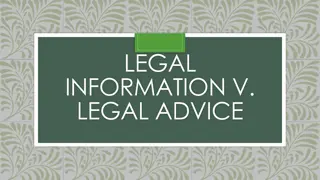
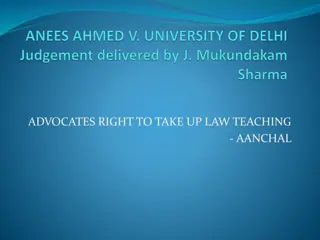
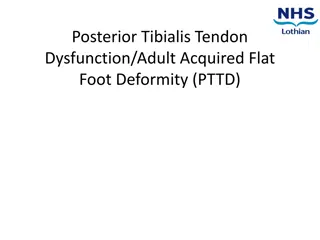
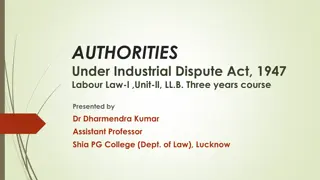
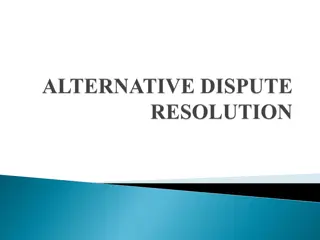

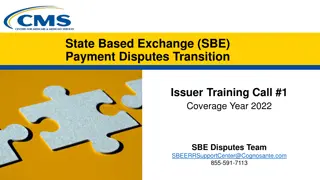

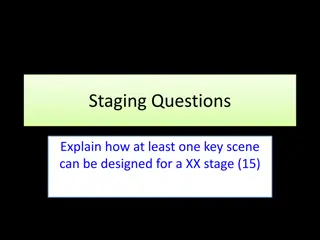

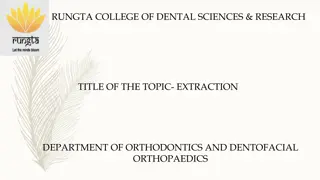
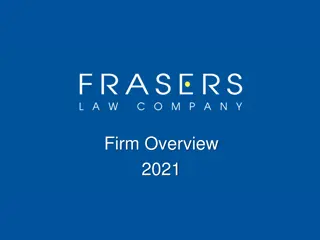
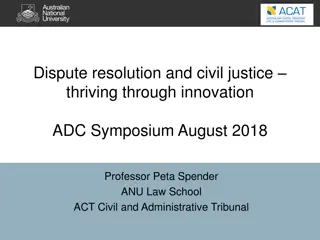
![Importance of Rock v. MWB [2018] UKSC 24 as Explained by Lord Sumption](/thumb/193348/importance-of-rock-v-mwb-2018-uksc-24-as-explained-by-lord-sumption.jpg)
